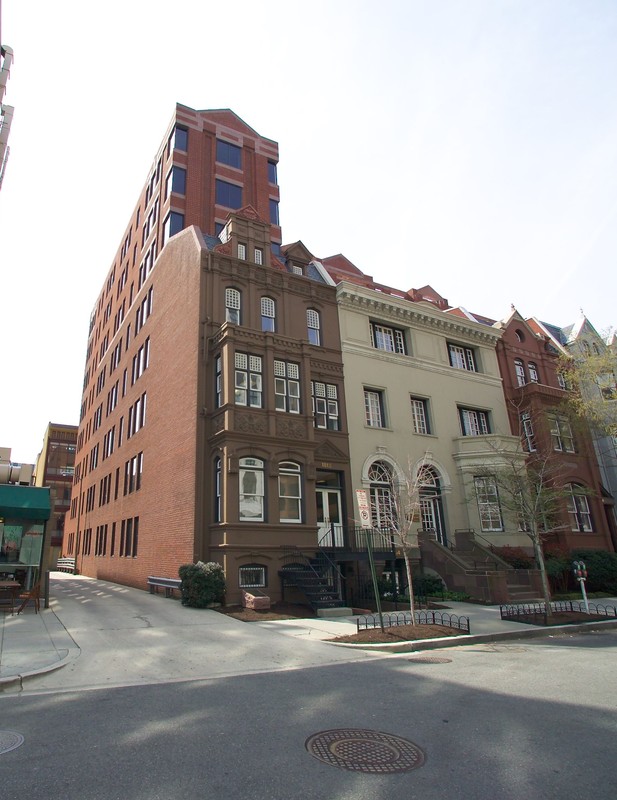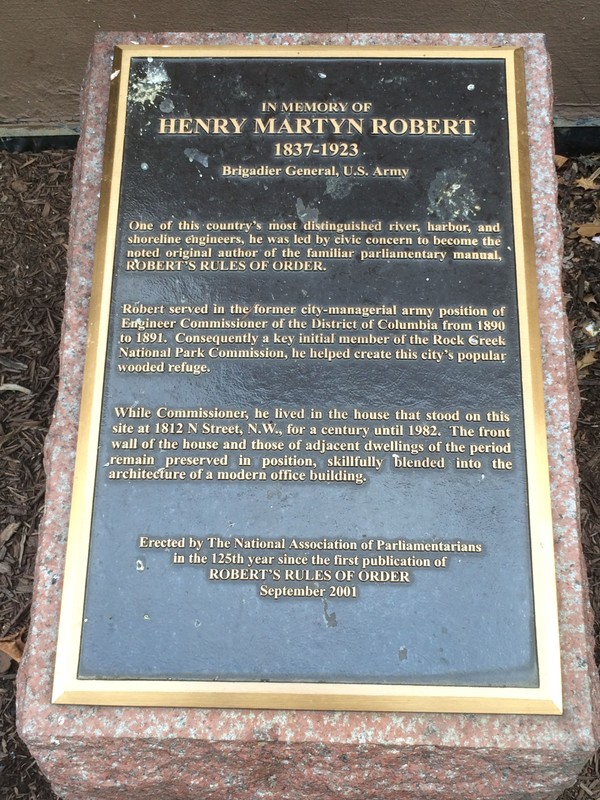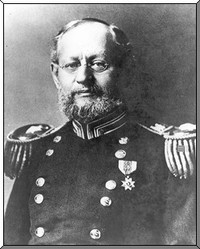Henry Martyn Robert Historical Marker
Introduction
Text-to-speech Audio
Leading 19th-century military engineer and author, Henry Martyn Robert (1837-1923), lived in a house that once stood here while he served as Engineer Commissioner of the District of Columbia between 1890 to 1891. A historical marker honoring him is located just in front of the building. Robert is best known for writing an authoritative manual on parliamentary procedure titled "Robert's Rules of Order" in 1876. It outlined the rules and practices organizations of any kind and size should follow when conducting meetings. The rules are widely used today. As a military engineer, Robert oversaw various federal projects throughout the country, including devising plans to develop Galveston, Texas into a major port city. The facade of the house (1812 N St. NW) and the adjacent homes were preserved and incorporated into a modern office building.
Images
Robert's home stood at the east of where the modern building is today. Its facade and that of the other houses on the block were retained and incorporated into the building.

The historical marker is located on the ground in front of the site of Robert's house.

Henry Martyn Robert (1937-1923)

Robert attended West Point and graduated with honors in 1857.

Backstory and Context
Text-to-speech Audio
Henry Martyn Robert was born on May 2, 1837 in Robertville, South Carolina on his grandfather's plantation. His father, Joseph, was a Baptist minister and a teacher. Joseph and Robert's mother, Adeline, were staunch abolitionists and decided to move the family to Ohio (a free state) when Robert was a young teenager. He was accepted in to the United States Military Academy at West Point when he was 16 and graduated with honors in 1857.
Robert taught there for one year before being assigned to San Juan Island in the Puget Sound, which is an inlet of the Pacific Ocean along the coast of the state of Washington. Robert, who had risen to the rank of Second Lieutenant in the Army Corps or Engineers by then, was in command of a ten-man detachment that was tasked with building a redoubt (an earthen defensive fortification) on the island. At the time, the boundary in the Puget Sound between the United States and Canada, which was a British colony, was still disputed. A confrontation between the U.S. and Britain almost broke out in 1859 when an American settler killed a pig that kept eating his crops. However, the pig belonged to a large Canadian fur trading business called the Hudson Bay Company, which requested the help of the British military to provide support. Three British warships arrived with 70 guns and 2,140 men but it became clear that Robert's redoubt could fend off an attack. To prevent any further escalation, the two sides agreed to jointly occupy the island with a small force for each. The remains of Robert's redoubt still exist and are well preserved.
During the Civil War, Robert developed plans to defend the city of Washington and Philadelphia harbor. Over the next three decades, he was assigned to projects around the United States. These included the construction of fortifications on the San Juan Islands in the Puget Sound, developing harbors of northern Wisconsin and Michigan ports, and supervising the construction of lighthouses on the Great Lakes. He drafted a proposal to develop Galveston at the end of the 1880s and the work was finished in 1895.
Robert first became interested in parliamentary procedures when he was in New Bedford, Massachusetts in 1862-1863. He was there to recuperate from contracting malaria in Panama on his return journey from the Puget Sound. He was asked to administer a meeting a Baptist church but lost control; he simply did not know to properly conduct a meeting. As a result, he began to research parliamentary procedures and slowly formulate his own. In 1867, he became chief engineer at the Military Division of the Pacific in San Francisco, and served on the board of trustees of a Baptist church and on the board of directors of the YMCA. His experiences on the boards compelled him to write a short pamphlet in 1869 outlining the procedures he developed. Then during the winter of 1873-1874 when he was in Milwaukee, Wisconsin (he was overseeing the construction of lighthouses on the Great Lakes at that time) he decided to write the first manuscript of Robert's Rules of Order. He finished it in 1875 and it was finally printed in book form in 1876 by a Chicago publisher. It was an immediate success as all 4,000 copies were sold in a few months. Robert revised the book many times and by 1915 over 500,000 had been sold.
Robert married his first wife, Helen, in 1860 and they had four daughters and one son. Helen died in 1895 and Robert married his second wife, Isabel, that year. After retiring in 1901, Robert served as chairman of the board of engineers that managed the construction of a seawall in Galveston, which had been struck by a hurricane the year before. Robert died in 1923 in Hornell, New York and was laid to rest in Arlington National Cemetery.
Sources
Chamberlain, Ellen. "Robert, Henry Martyn." South Carolina Encyclopedia." Accessed January 17, 2023. Last Updated August 23, 2022. https://www.scencyclopedia.org/sce/entries/robert-henry-martyn.
"Henry Martyn Robert." Encyclopedia.com. Accessed January 17, 2023. Last Updated June 8, 2018. https://www.encyclopedia.com/people/science-and-technology/civil-engineering-biographies/henry-martyn-robert.
"Henry Martyn Robert." National Park Service. Accessed January 17, 2023. https://home.nps.gov/people/henry-martyn-robert.htm.
"Historical Vignette 038 - An Army Engineer Brought Order to Church Meetings and Revolutionized Parliamentary Procedure." U.S. Army Corps of Engineers. November 2001. https://www.usace.army.mil/About/History/Historical-Vignettes/General-History/038-Church-Meetings.
Kline, Charles R. “Robert, Henry Martyn.” Handbook of Texas Online. Accessed January 17, 2023, https://www.tshaonline.org/handbook/entries/robert-henry-martyn.
The Historical Marker Database
Wikimedia Commons
